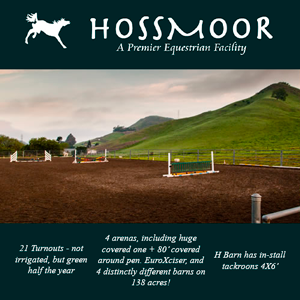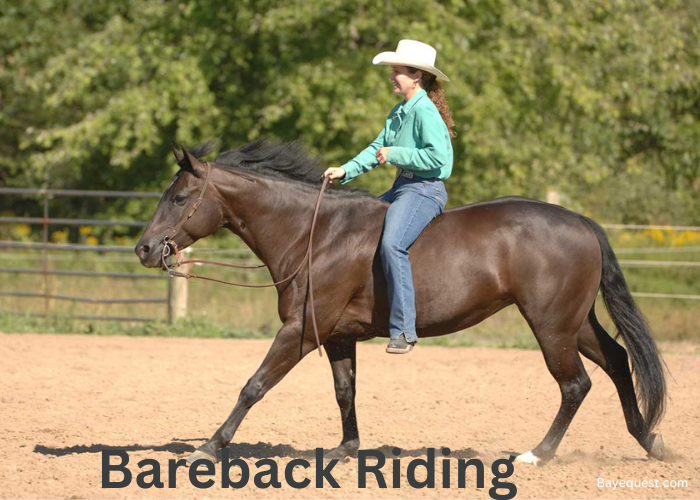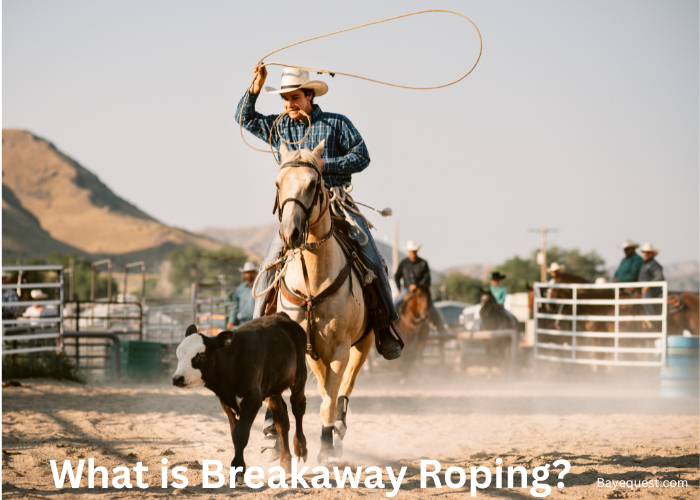Riding without a saddle? Sounds wild, but that’s exactly what bareback riding is all about. No stirrups, no leather seat, just you, your horse, and pure connection.
It’s not just for daredevils or show-offs. It’s for anyone who wants to feel every breath, every stride, and every shift in motion.
Sure, it takes balance, guts, and a bit of grit, but the freedom is unmatched.
Want to improve your riding skills fast? Or just feel closer to your horse? Bareback riding might be your next favorite challenge.
Let’s dive in, no saddle required.
What is Bareback Horse Riding?
Bareback riding is the art of riding a horse without a saddle.
No stirrups, no seat, no extra padding. It’s just you and the horse, with nothing in between but trust and balance.
Riders use their legs, core, and body awareness to stay in sync with the horse’s movements. It may look simple, but it takes real skill to master.
Bareback riding builds confidence, sharpens your feel for the horse, and helps you develop better posture. It’s raw, real, and brings you closer to your horse, literally.
Read also: What is Breakaway Roping?
History of Bareback Riding
Bareback riding is as old as horseback riding itself. Long before saddles, stirrups, or fancy tack were invented, humans rode horses using nothing but balance, grip, and instinct.
Ancient cave paintings and early writings suggest people in Central Asia and the Middle East were riding bareback thousands of years ago.
Over time, different cultures developed their own saddle designs to make riding safer and more comfortable.
But bareback never faded away. It remained a way to train young riders, build trust between horse and rider, and test true horsemanship.
What started as a necessity has become an art.
The Basics of Bareback Riding
Bareback riding strips things down to the essentials. No saddle. No stirrups. Just balance, connection, and feel. But before you jump on, here’s what you need to know:
Start with the right horse. This isn’t the time for wild rides. Choose a calm, steady horse, one that won’t spook, bolt, or act up. Think schoolmaster, not rodeo star.
Keep it simple. Your first bareback ride isn’t about speed or tricks. Just walk. Get used to the feel. You’ll probably tire faster because bareback works muscles you didn’t know you had.
Ride in the right place. No trails, no chaos, no surprises. Pick a flat, quiet area with soft footing. A round pen or grassy paddock is perfect.
Dress for the ride. Long pants, boots, and a helmet. Skip anything that might rub, slip, or cause distractions. Comfort equals confidence.
Don’t rely on the reins for balance. Gripping the reins too tightly can confuse your horse. Use your core and legs for balance, as your hands are for light communication only.
Stay relaxed, not rigid. Tensing up makes it harder to stay centered. Keep your body soft, your legs relaxed, and your seat flexible. Let your body move with the horse.
Use a neck rope or grab strap. If you feel unsteady, use a neck rope or strap (attached to the front of the bareback pad or halter) for balance instead of the reins.
Keep your heels down. Even without stirrups, the “heels down” rule still helps. It improves your stability and lowers your center of gravity.
Work on transitions slowly. Moving from walk to trot bareback can feel like a jolt. Practice smooth transitions and stay centered through the change in rhythm.
Stay aware of the horse’s comfort. Your seat bones are directly on their back. Keep your posture soft and centered to avoid causing discomfort or soreness.
The Benefits of Riding Bareback
Riding without a saddle may look simple, but it comes with big rewards:
1. Builds a better balance
No stirrups or saddle to rely on means your body learns to stay centered, fast. Your core, legs, and seat all get stronger.
2. Improves your riding skills
Bareback forces you to ride with feel. You learn to move with the horse instead of bracing against the saddle.
3. Deepens the rider-horse bond
There’s nothing between you and the horse. You feel every step, every shift. It’s a more connected, intuitive experience.
4. Teaches you to stay calm
Bareback riding keeps you humble. It teaches patience, softness, and how to stay relaxed even when things feel wobbly.
5. Makes you a more confident rider
Once you’re solid bareback, riding with a saddle feels easy. You’ll notice better posture, more control, and less fear.
6. Adds variety and fun
Sometimes, ditching the tack makes things more fun. It’s a great way to switch up your routine and enjoy some freedom.
The Drawbacks of Bareback Riding
Bareback riding has its perks, but it’s not all smooth sailing. Here are a few downsides to keep in mind:
1. Less security
No saddle means no stirrups, no seat, and nothing to grab if you lose balance. Falls are more likely, especially for beginners.
2. Harder on your muscles
Riding bareback works muscles you don’t usually use, especially in your legs and core. Expect soreness after your first few rides.
3. Can be uncomfortable
Your seat bones are on the horse’s back, and the horse’s spine can feel bony. It’s not always the most pleasant ride, especially for long sessions.
4. Tougher at faster gaits
Trotting or cantering bareback is bouncy. Without stirrups to absorb the motion, staying balanced takes serious skill and control.
5. Not for every horse
Some horses don’t like the feel of a rider directly on their back. They might tense up, hollow their back, or get irritated.
6. More risk of slipping
Without a saddle, there’s nothing keeping you from sliding off if the horse turns sharply or moves suddenly.
Why Do Riders Go Bareback?
Some riders do it for fun. Others do it to feel closer to their horse. But for many, bareback riding is a way to sharpen their skills.
Without a saddle, your body has to do the work. You learn to balance better, sit deeper, and move with your horse, not against it. It’s also a great way to build strength, especially in your legs and core.
Riders also love the freedom. No tack. No fuss. Just a raw, real connection.
Every step, every breath, you feel it all. That’s the magic of bareback.
How to Ride a Horse Bareback: Step-by-Step Guide
Step 1: Choose the right horse. Pick a calm, well-trained horse that’s comfortable being ridden without a saddle. Avoid young or unpredictable horses for your first try.
Step 2: Groom thoroughly. Brush your horse’s back to remove dirt, debris, or loose hair. This will protect both of you from irritation.
Step 3: Use a bareback pad (Optional). If you want extra grip and comfort, use a bareback pad. It provides some cushioning while maintaining the natural feel.
Step 4: Mount carefully. Use a mounting block or find a safe way to swing up gently. Keep your horse still and calm while you get on.
Step 5: Find your seat. Sit upright and balanced over your horse’s center. Let your legs hang naturally, lightly hugging the horse’s sides. Avoid gripping too tightly.
Step 6: Keep your hands light. Hold the reins gently. Don’t use them for balance—use your core and seat instead.
Step 7: Start at a walk. Begin with a walk to get used to the movement. Stay relaxed, breathe, and move with the horse’s rhythm.
Step 8: Practice stopping and turning. Use soft rein cues and shift your weight to steer and stop.
Step 9: Try other gaits slowly. Once you’re comfortable at the walk, you can try a trot or canter, but only when you’re ready. Stay centered and soft.
Step 10: Dismount safely. Slide off gently, landing on both feet. Always dismount in a calm area, and check your horse for any back soreness afterward.
Is Bareback Riding Safe?
Yes, bareback riding can be safe, but it depends on how and where you do it.
Riding bareback comes with more risk than riding with a saddle. There’s nothing to hold you in place, no stirrups for support, and no padding between you and the horse.
A sudden spook or slip can send you flying faster than you’d expect.
That said, bareback riding can be safe when done with the right horse, in the right setting, and with the right mindset.
Choose a calm, experienced horse. Ride in a quiet area with soft, even ground. And always wear a helmet.
Start slow. Stay relaxed. And never use bareback as a chance to show off.
Done responsibly, it’s a powerful way to build trust, skill, and connection.
Bareback Riding Tips for Beginners
Are you just getting started? These tips will help you stay safe, balanced, and confident on your first ride.
- Choose a calm, well-trained horse.
- Use a bareback pad if you need extra grip or comfort.
- Ride in a flat, quiet area with soft footing.
- Keep your heels down to stay balanced.
- Don’t grip the horse with your knees.
- Sit upright and stay centered over the horse’s back.
- Start at a walk before trying faster gaits.
- Use your core muscles for stability.
- Keep your hands light on the reins.
- Wear a helmet, long pants, and proper boots.
- Stay relaxed and move with the horse’s rhythm.
- Keep early rides short to avoid muscle fatigue.
- Practice stopping and turning gently.
- Avoid using the reins for balance.
- Always dismount slowly and safely.
Common Mistakes to Avoid When Bareback Riding
Bareback riding can be fun and rewarding, but it’s easy to make mistakes, especially when you’re just starting out. To keep things safe and smooth, here are some common errors to watch out for.
- Riding a nervous or unpredictable horse.
- Skipping the warm-up and jumping straight into fast gaits.
- Using the reins for balance instead of your core.
- Riding on uneven, slippery, or unsafe ground.
- Ignoring the horse’s signals or discomfort.
- Skipping safety gear like a helmet or proper boots.
- Staying stiff and not moving with the horse.
- Forgetting to groom the horse’s back before riding.
- Not checking your own posture during the ride.
- Riding without any supervision or support as a beginner.
Best Horses for Bareback Riding
1. Quarter Horse
Quarter Horses are one of the most popular choices for bareback riding. Their calm temperament, reliable nature, and smooth, balanced gaits make them beginner-friendly.
They’re also well-muscled and typically have broad backs, which provide a more comfortable seat with better support.
2. Morgan
Morgans have a natural balance, athleticism, and kind personalities. They respond well to subtle cues, which is ideal for bareback riders who rely more on seat and leg aids than reins.
Their compact build and smooth movement make them easy to ride without a saddle.
3. Arabian
While Arabians can be spirited, many are intuitive and form deep connections with their riders.
Their lighter frame and graceful movement can be comfortable bareback, especially for more experienced riders. They’re also intelligent and quick to adjust to your body language.
4. Appaloosa
Appaloosas are dependable, steady, and known for their strong work ethic. They usually have wide backs and even temperaments, making them ideal for bareback riding.
Many were also raised in environments where versatility was expected, so they adapted quickly to different riding styles.
5. Paint Horse
Closely related to the Quarter Horse, Paints offer many of the same traits: calmness, smooth gaits, and a sturdy frame.
Their broad backs and forgiving personalities make them great bareback partners, especially for relaxed rides and slow work.
6. Tennessee Walking Horse
These horses are famous for their smooth gaits, which feel like gliding instead of bouncing. That makes them one of the most comfortable breeds to ride bareback, even at faster speeds.
They’re also usually gentle and cooperative under saddle or without one.
7. Mustang
Mustangs are hardy, surefooted, and highly aware of their environment. Once trained and bonded with a rider, they’re incredibly responsive and reliable.
Many have wide, strong backs and excellent balance, making them solid bareback choices for trail riding or arena work.
8. Draft Crosses
Draft crosses (such as Percheron-Quarter Horse mixes) combine strength and calm demeanor.
Their larger frames and broad backs offer a roomy, cushioned ride, which is perfect for bareback comfort. They’re typically laid-back and not easily startled.
9. Friesian
Elegant and powerful, Friesians offer a smooth, elevated ride and often a deep connection with their rider.
Their collected movement and balanced stride help bareback riders stay centered. They’re also affectionate and eager to please.
10. Icelandic Horse
Small but mighty, Icelandic horses are famous for their unique tölt gait, which is incredibly smooth.
Their shorter stature makes mounting easier, and their sturdy build supports bareback riding comfortably.
They’re also tough, smart, and a joy to ride bareback on trails or open fields.
See also: Perfect Horses for Jumping.
Bareback Riding Vs Saddle Riding
Bareback riding and saddle riding offer two very different experiences. Riding with a saddle gives you more security and support, especially with stirrups to help your balance.
It’s easier on your body during long rides and offers more control, especially at faster gaits. In contrast, bareback riding brings you closer to the horse.
You feel every movement and shift, which helps improve your balance and riding skills.
However, it’s less comfortable, and there’s a higher risk of falling, especially for beginners. Saddle riding is great for structure and safety, while bareback is ideal for building a stronger bond and learning to ride with feel.
Many riders use both styles depending on their goals. One isn’t better than the other, they just serve different purposes and teach you different things.
Fun Bareback Horse Riding Activities
Bareback riding can be a lot of fun. Here are a few enjoyable activities to try once you’ve built up your balance and confidence:
1. Bareback trail rides. Take it slow and scenic. Riding through open fields or quiet trails without a saddle lets you truly feel the rhythm of your horse and the world around you.
2. Water rides. If your horse is comfortable with water, try walking bareback through a shallow stream or pond. It’s refreshing, and many horses love the splash.
3. Liberty work. Mix bareback riding with groundwork and liberty training. It builds trust and deepens your connection with your horse.
4. Obstacle courses. Set up simple challenges like walking over poles or weaving through cones. It keeps things interesting and sharpens your communication.
5. Bareback games. Try friendly games like egg-and-spoon races, Simon Says, or balance challenges. These are especially fun during barn days or group lessons.
6. Practice meditation rides. Use a slow, bareback ride to unwind. Focus on breathing, movement, and mindfulness. It’s a calming way to connect with your horse.
Riding Horse Bareback: Conclusion
Bareback riding is simple, challenging, and deeply rewarding. It teaches balance, improves your riding skills, and brings you closer to your horse.
While it comes with risks, the benefits can be huge when done safely and thoughtfully. Whether building confidence or just switching up your routine, riding without a saddle can open new doors.
Start slow, stay safe, and enjoy the ride. And remember, you don’t need fancy gear to connect with your horse.
Sometimes, less really is more. Ready to give it a try? Your bareback journey starts with one step.







